Migration: helping Scotland prosper
Paper detailing how a tailored migration policy, within a UK framework, could operate to meet Scotland's distinct needs.
Annex B: Scotland’s distinct population and migration needs
Scotland’s Population In Recent History
Scotland’s history of migration is different to that of much of the rest of the UK. The dominant migration story through much of Scotland’s history has been a story of out migration, of people leaving Scotland to build their future elsewhere. Throughout much of the twentieth century while England and Wales saw strong in-migration Scotland experienced population decline. It is only since 2001 that Scotland has been in a period of sustained net in-migration, driven by the growth in both the numbers of EU citizens and those from the rest of the UK coming to live and work in Scotland.
Figure 5: Components of Scotland’s population change, 1957-2018
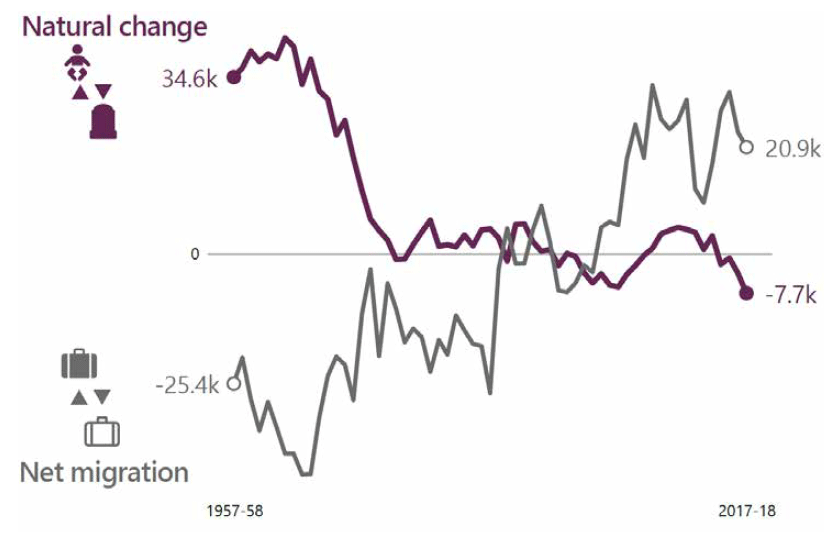
Source: National Records of Scotland
Free movement has enabled people from across the EU to live, work and study here, helping to grow Scotland’s working age population and Scotland. Scotland has also benefitted economically and culturally from the people who have chosen to make their home here and to make a positive contribution.
In the year to mid-2018, migration alone contributed to Scotland’s population growth with 20,900 more people coming to Scotland than leaving. This is a reduction from +23,900 people in the year to mid-2017 and +31,700 people in the year to mid-2016, and coincides with the period after the UK’s decision to leave the EU.
Overall, 7% of the resident population of Scotland have non-British nationality. Of all non-British nationals living in Scotland, 237,000 (64%) were EU nationals and 135,000 (36%) were non-EU nationals in the year-ending June 2019. Over half of EU nationals living in Scotland were from EU8 countries.
However, Scotland’s history of out-migration and population decline has left a structural legacy. Communities, especially rural communities, did not just lose those individuals who left, but also lost potential future generations of their children and grandchildren. That legacy means that Scotland is more reliant on migration than elsewhere in the UK.
Figure 6: Number of non-British nationals living in Scotland, year-ending June 2019
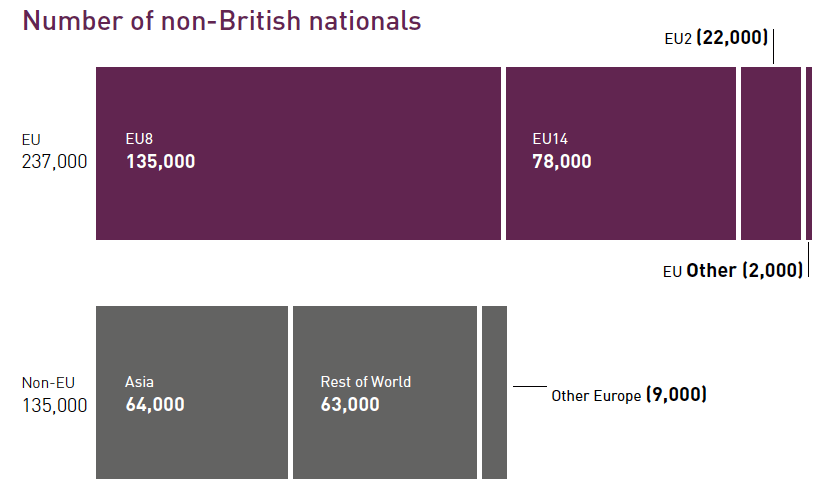
Source: National Records of Scotland
At the same time as migration has grown, natural change has not contributed to Scotland’s recent population growth: there were 7,700 more deaths than births in the latest year. This is the largest natural decrease on record to date. The number of births in Scotland continued to fall in 2018. There were 51,308 live births registered in 2018, the lowest annual total since 2002 and the second lowest annual total since records began in 1855.
This means that Scotland has an unbalanced population: a growing older population and decline in the number of children.
Figure 7 shows the age structure of the population in Scotland and the UK in the year to mid-2018. Currently, Scotland has a lower than average share of the population who are 20 or younger – due to a lower birth rate. Scotland has a higher than average share of the population who are 50 or older.
Figure 7: Age structure of the population, Scotland and the UK, year to mid-2018
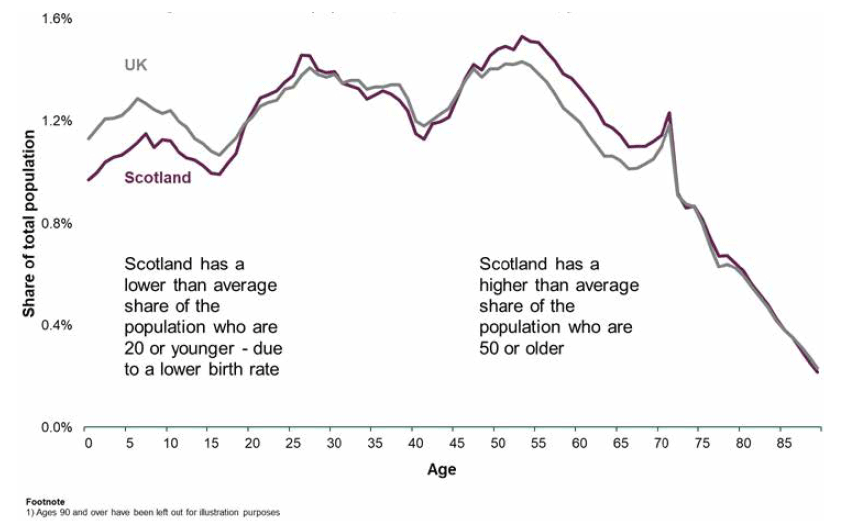
Source: National Records of Scotland
Population growth is also not distributed evenly across all areas. Last year 14 of Scotland’s local authorities, or nearly half, experienced depopulation.
Figure 8: Population change across Scotland’s local authorities, 2017-2018
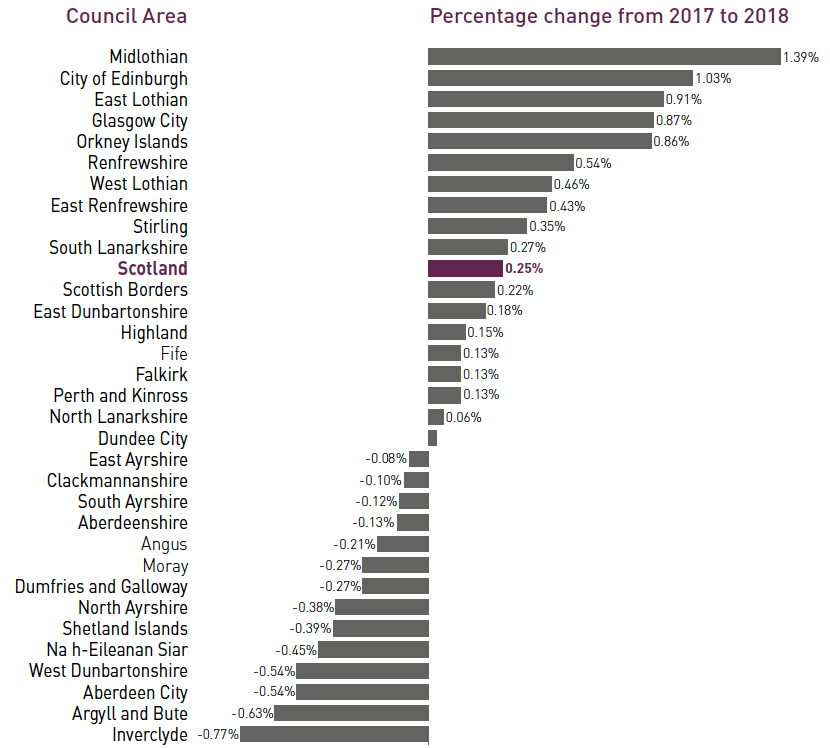
Source: National Records of Scotland
A number of nations are facing similar issues of an ageing population, a declining birth rate and population decline in rural communities. Scotland’s challenges are more pronounced when compared to the experience in other parts of the UK but are not untypical when compared to the issues facing many other nations.
Research by the Expert Advisory Group on Migration and Population published in November 2019 shows how Scotland’s average annual population growth has compared with the rest of Europe (Figure 9).
Figure 9: Average annual population growth rate by NUTS 3 region (per inhabitants), 2013-2018.
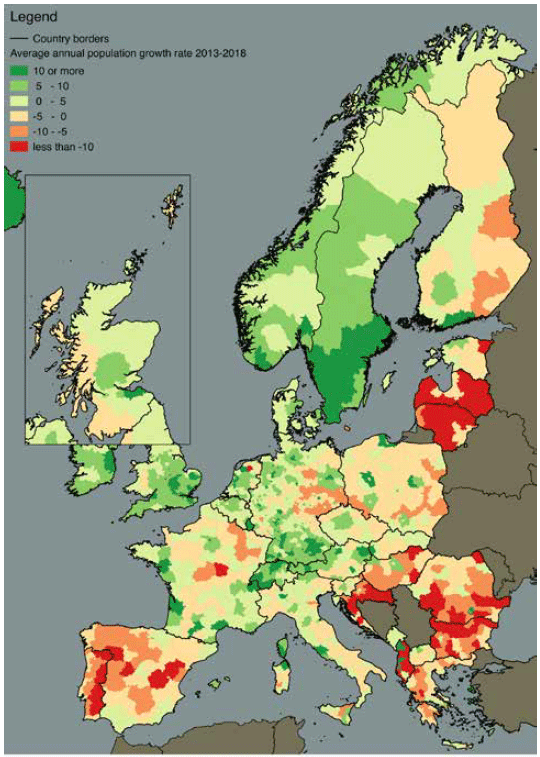
Source: Expert Advisory Group on Migration and Population
In Scotland the areas experiencing depopulation are mostly rural or island communities as well as areas in the West of Scotland. The James Hutton Institute has undertaken research on Sparsely Populated Areas of Scotland (Figure 10). While these areas contain only 2.6% of Scotland’s population they extend to almost half of the land area of Scotland. It is the scale and potential impact of the issue which makes it a distinctive challenge for Scotland and a challenge which needs to be addressed.
Figure 10: Sparsely Populated Areas of Scotland and its sub-regions
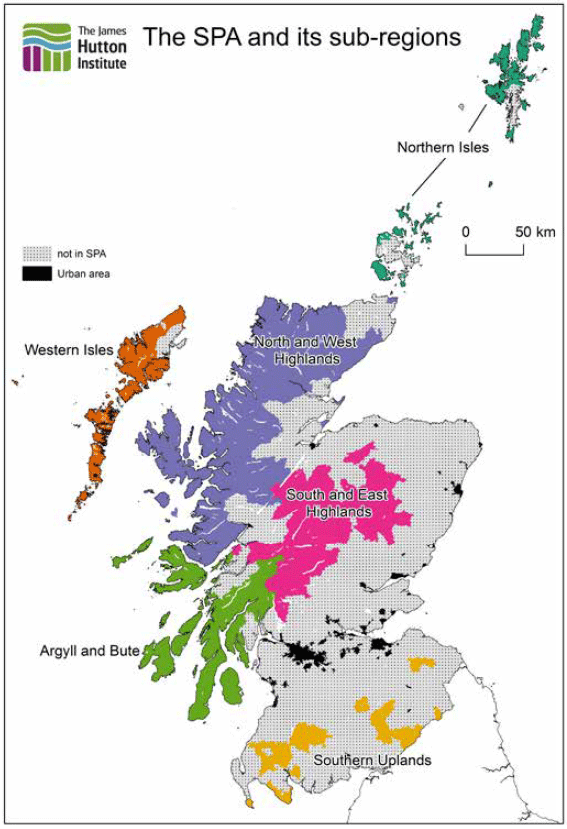
Source: The James Hutton Institute
As other nations have experienced the challenge of depopulation and population ageing they have developed solutions to deal with these challenges, including tailored migration policies.
Scotland’s Population In Future
The structure of Scotland’s population is therefore strongly influenced by a history of out-migration. These demographic challenges, including geographical aspects, are felt more sharply in Scotland than elsewhere in the UK.
This will have an impact on future population change as well. National Population Projections are released every two years. The 2018-based projections for Scotland were published in October 2019 by National Records of Scotland, along with projections for the UK produced by the Office for National Statistics.
The projections are widely used in planning of public services, resource allocation, understanding potential demand for health services including the impact of our ageing population and teacher workforce planning. They are also used by the independent fiscal institutions, the Office for Budget Responsibility and the Scottish Fiscal Commission, to inform their economic and fiscal forecasts. However, they do not make any assumptions about future policy change and therefore do not reflect the ending of free movement.
The 2018-based National Population Projections show Scotland’s population is projected to continue to increase, by 1.8% in the first ten years of the projections, and by 2.5% over 25 years to reach 5.57 million by mid-2043. There is considerable variation across Scotland in relation to projected population growth. Research from the James Hutton Institute suggests that Scotland’s sparsely populated areas are set to lose more than a quarter of their population by 2046.
Figure 11: Projected population of Scotland, mid-2018 to mid-2043
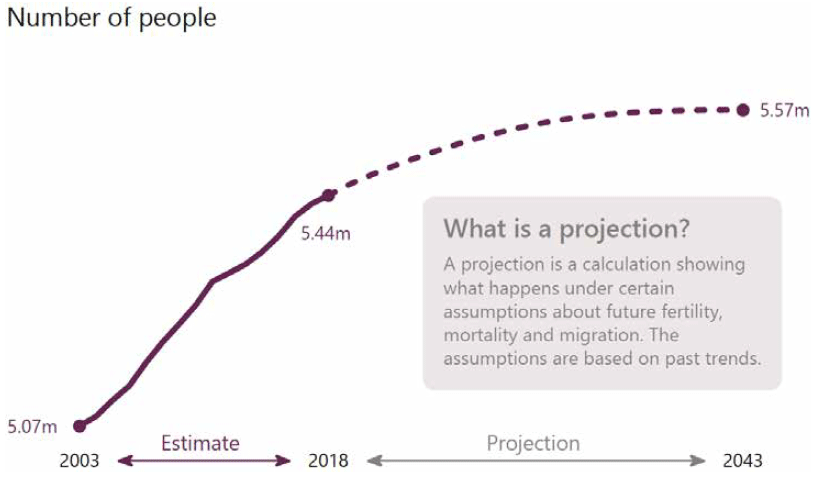
Source: National Records of Scotland
All of the projected growth in Scotland’s population is from inward migration. There is no natural growth projected, with more deaths than births projected each year going forward.
Scotland’s population growth is projected to be slower than previously expected. There are projected to be just under 125,000 people less in mid-2043, compared to previous projections.
Figure 12: Projected rate of Scotland’s population growth, mid-2018 to mid-2043
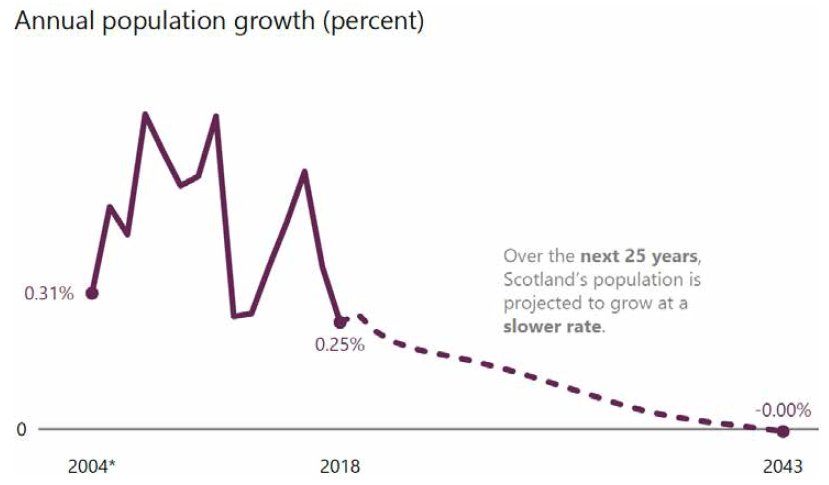
Source: National Records of Scotland
Although Scotland’s population is projected to grow in the period up until mid-2043, growth could stall as the levels of migration are outweighed by natural decline in the population.
By mid-2043, there are projected to be 18,800 more deaths than births which would be the largest natural decrease on record. Net migration is projected to be positive in mid-2043 with an estimated 18,500 more people coming to Scotland than leaving. This means that Scotland’s population could start to decline at the end of the projection period, as negative natural change is estimated to be greater than positive net migration.
Scotland’s population is projected to continue an ageing trend. Over the 10 years to mid-2028 there are projected to be 38,100 more people of pensionable age in Scotland with the number projected to increase by 240,300 in the 25 years to mid-2043.
Figure 13: Projected population of Scotland by age group, mid-2018 to mid-2043
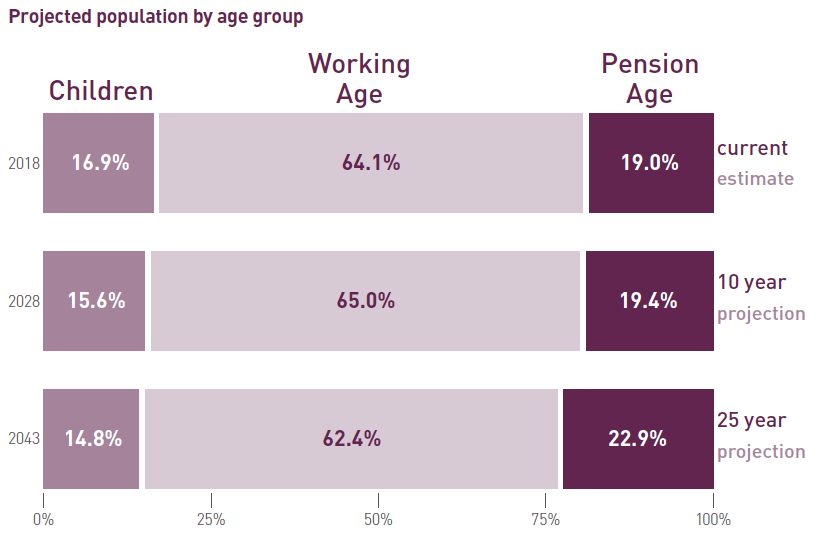
Source: National Records of Scotland
Scotland’s working age population is projected to be slightly smaller in mid-2043 than in mid-2018. In mid-2018, there were approximately 3.484 million working age people in Scotland, making up 64% of the population. In mid-2043, the working age population is projected to be 3.477 million, making up 62% of the population. The reduction in the working age population is a particular issue in rural communities. The James Hutton Institute has estimated a 33% reduction in the working age population by 2046 in sparsely populated areas.
The population of the UK as a whole is projected to grow at a faster rate than Scotland, increasing by 9.0% to reach 72.4 million by mid-2043. If these changes were realised, Scotland’s share of the UK population could fall from 8.2% to 7.7% by mid-2043.
The working age population of the UK is projected to increase by 6.4% by mid-2043, whereas Scotland’s working age population is projected to be very similar to mid-2018 levels.
The UK as a whole is projected to experience more births than deaths, with 16% of its projected population growth coming from this. In Scotland, migration is the only projected driver of population growth.
Impacts Of Reduced Migration
Jakob
Builder
Pictured in Aberdeen
Born in Poland

The population projections use assumptions about future migration (as well as fertility and mortality) that are based on past trends and are not intended to be forecasts. This means the projections do not attempt to predict the impact of policy or political circumstances, such as the UK leaving the EU and ending free movement.
As well as the principal projections and standard variants, NRS also produce illustrative variants using alternative assumptions about future EU migration. These provide illustrations of the possible effect on the population of changes in levels of EU migration.
Changes to migration affect the age structure of the population in Scotland more than in the rest of the UK. If EU migration is reduced, it is projected the working age population in Scotland will decline at a faster rate than otherwise anticipated. It is projected to continue to grow in the rest of the UK in all scenarios. Figure 14 illustrates this projected change in working age population in both Scotland and the UK. The principal projection assumes no change to migration policy, while the variant projection shows the impact of removing all EU migration.
In a scenario of 50% less EU migration, Scotland’s population is projected to grow at a slower rate and start to decline after 2033. Overall, the population would still grow but only by 1.0% over the 25 year projection period to mid-2043, compared to 2.5% using the principal projection.
The UK population is projected to grow faster than Scotland’s in the principal projection and in both of the additional EU migration variants. In the scenario of 50% less EU migration, the UK population would grow by 7.7% over the next 25 years, compared to 1.0% for Scotland. This is why EU migration is so crucial to Scotland’s future population growth and prosperity.
Figure 14: Projected change of components of Scotland and UK population growth, mid-2018 to mid-2043 using variant future migration scenarios
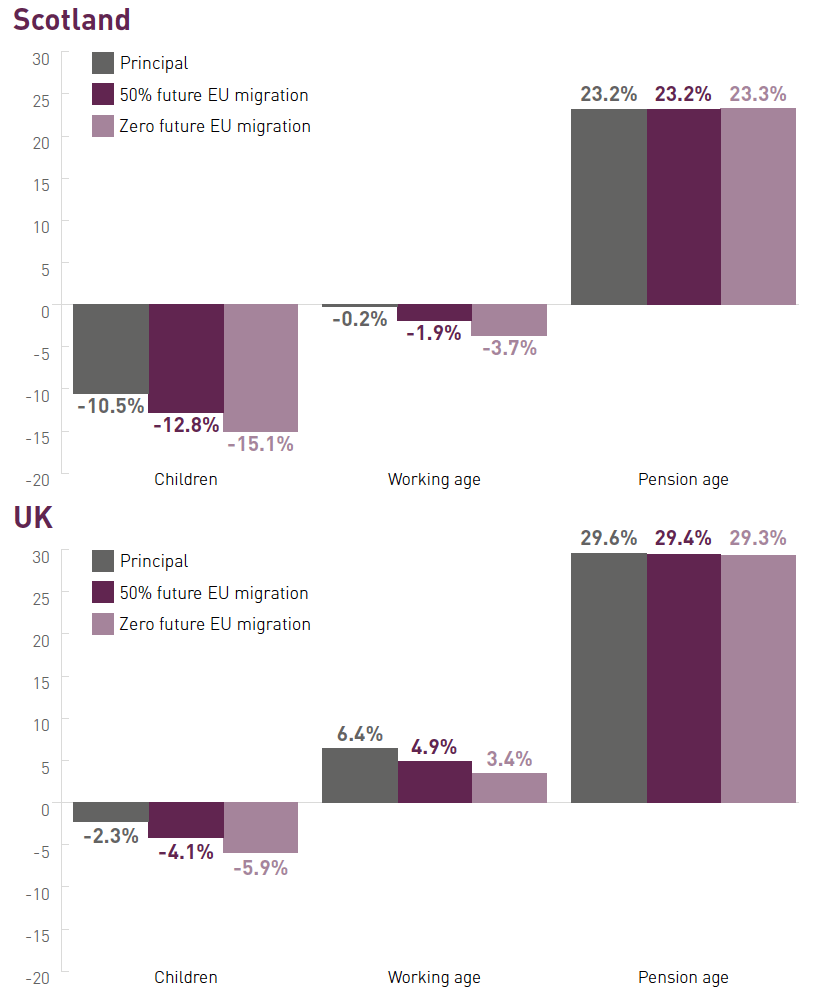
Source: National Records of Scotland
In scenarios of reduced EU migration, Scotland is projected to experience a much faster rate of shrinkage to the size of its working age population whilst the UK continues to see projected increases.
The Scottish Fiscal Commission employs the 50% less EU migration variant projection in their economic and fiscal forecasts. The Commission has warned of the specific risk to Scotland of reduced migration on the size of the tax-paying working age population repeatedly in their forecasts, stating:
“The size of the population aged 16 to 64, which makes up most of the working age population, is very important for the economy and the public finances. These individuals are more likely to be working and will be generating the highest tax receipts, for example, in income tax.”
The fiscal framework agreed between the Scottish Government and the UK Government in respect of the devolved taxes insulates the Scottish budget from differences in overall population growth. However, this does not protect the Scottish budget from all demographic change. The budget is not protected from a reduction in the proportion of the population accounted for by working age people, and a consequent reduction in tax revenues per head.
The Scottish Government said, in response to a Finance Committee report on the 2019 Scottish Budget, that the upcoming review of the Fiscal Framework should investigate how demographic change needs to be further reflected in the Fiscal Framework.
External think tanks and research institutes have also highlighted the challenge of potential reductions in migration to Scotland. The Fraser of Allander Institute have shown that, while immediate impacts of leaving the EU, for example on trade, will heavily determine the future of Scotland’s economy: ‘arguably a bigger challenge is what [leaving the EU] might mean for Scotland’s population’. They say that:
“[a] significant proportion of Scotland’s long-term growth gap with the UK can be explained by population growth. Should Brexit make in-migration more difficult – or less attractive – then this could have implications for key sectors and the economy at large.”
Figure 15: Average annual growth rate (over 10 years) of GDP
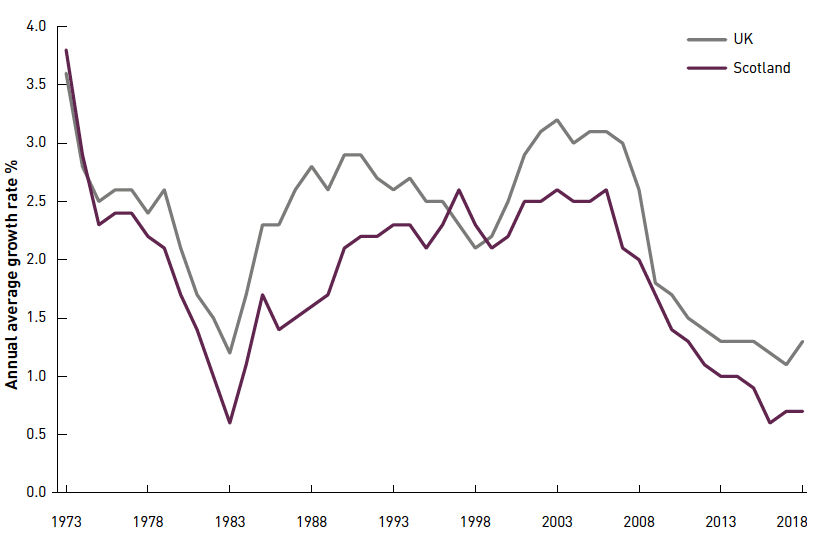
Source: Fraser of Allander Institute
The Fraser of Allander Institute in Figure 15 take a long-run view (10 year rolling average) of GDP growth (i.e. the size of the economy) . Throughout the 1980s and early 2000s, the UK economy as a whole grew more quickly than the Scottish economy. This reflects the general trend that GDP growth rates tend to be positively correlated with population growth rates. With larger populations, in particular the working age population, countries have greater economic capacity, allowing them to produce more goods and services.
In Figure 15 the periods where GDP in Scotland grew more closely to that of the UK as a whole can be directly linked to periods where Scotland’s population growth was also similar. With migration projected to be the sole driver of population growth in Scotland over the next 25 years, it is not difficult to see its central importance. Any attempts to reduce migration will have adverse economic impacts.
Similarly, evidence suggests that migration boosts long term GDP per capita, through increased diversity of skills and through higher innovation activity. In-migration is found to have both direct effects on company productivity as well as indirect impacts by raising the productivity of resident human capital through knowledge transfer.
Additional economic modelling conducted by the Scottish Government found that there would be a proportionately larger economic impact in Scotland as a result of reduced levels of migration than there would in the rest of the UK.
The modelling estimates that real GDP in Scotland will be 4.5% lower by 2040 than it would have been otherwise, as a result of lower migration. This is equivalent to almost £5 billion in GDP by 2040. The impact across the rest of the UK of a corresponding reduction in migration is found to be smaller. The model results show real GDP in the rest of the UK will be 3.7% lower by 2040 than it would have been otherwise, as a result of lower migration. These results reflect the greater reliance Scotland has on migration when compared to the rest of the UK.
Growing the working age population is recognised as an important component of Scotland’s economic and labour market strategies. The projected decline in working age population is one of Scotland’s key economic challenges, with the negative impacts likely to be felt unevenly throughout Scotland.
Scotland experiences a proportionally larger negative economic impact – relative to the rest of the UK – if the size of its working age population shrinks. The proportionately larger impact on Scotland is equivalent to £1.2 billion a year by 2040.
Figure 16: Change in real GDP, Scotland and rest of the UK from lower working age population
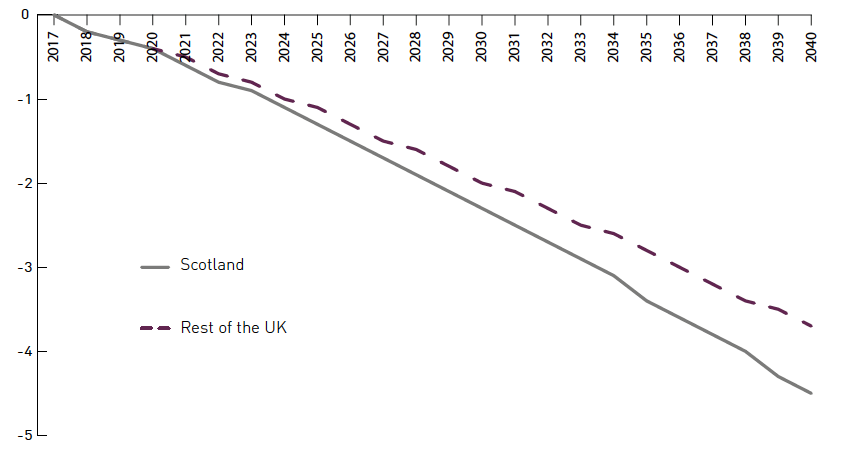
Source: Scottish Government
The Scottish Government asked the independent Expert Advisory Group on Migration and Population to consider the impacts in Scotland of expected changes to the UK immigration system.
In their report on UK Immigration Policy After Leaving the EU: Impacts on Scotland’s Economy, Population and Society, published in February 2019, the Expert Advisory Group estimate a 30-50% reduction in migration to Scotland over the next two decades as a consequence of the UK Government choosing to end free movement as it leaves the EU, and imposing a more restrictive system in its place.
This would potentially result in the working age population in Scotland declining by as much as 5%. That contrasts sharply with the position in the rest of the UK where, assuming the same immigration scenarios, the working age population would continue to grow.
Restricting routes for EU migrants would be particularly disruptive for Scotland’s remote rural and island areas. The relatively older age structure of these areas means that inward migration is the only practical method of countering depopulation.
The indirect consequences of reduced migration are also important. For example, a focus on only highly paid migrants is likely to lead to sectoral shortages in lower to medium wage areas including social care. In the social care example reduced migration could adversely affect female family members who themselves are most likely to exit the labour market to cover gaps in care provision that would have otherwise been delivered by a migrant workforce.
Broader Benefits Of Migration
The economic benefits of migration are well-understood, and there is an extensive evidence base to support that, at both Scotland and UK level.
The Scottish Fiscal Commission noted in their May 2019 economic and fiscal forecast report that they ‘expect growth in Scottish GDP to be significantly lower than in the UK, primarily because of slower population growth in Scotland’. The Fraser of Allander Institute analysis of GDP statistics observed that ‘population growth and migration issues are central in discussions about the Scottish economy, and attracting more people to live and work in Scotland is important f or long—term prosperity.’
Scottish Government analysis shows that, on average, each additional EU citizen working in Scotland adds over £10,000 to government revenue and over £34,000 to GDP, each year. If migration from the EU was to fall by half after the UK leaves the EU, this could mean GDP in Scotland being 6.2% lower by 2040 than it would have been otherwise. This is equivalent to almost £6.8 billion per year by 2040.
The MAC compiled a comprehensive assessment of the impacts of EEA migration on the UK labour market for their 2018 report. This considered a wide range of impacts using both quantitative and qualitative evidence. While in some cases the evidence on impacts is clear, and others less so, their key findings, summarised in Figure 17, show that those migrants make a net fiscal contribution to the UK – that is, they pay more in taxes than they receive in public services – and that migration increases innovation and productivity. Conversely, the MAC also show that there is no evidence EEA migration has reduced wages or employment and training opportunities for those in the UK.
Even where the MAC does identify potential issues concerning the impact of migration, they acknowledge there is significant uncertainty in the evidence base, and often other factors at play.
Overall, the analysis by the MAC is a credible and authoritative assessment of the impact of migration in the UK. It explicitly refutes many of the most common arguments made to oppose an open and flexible approach to migration generally, and free movement of people within the European Single Market specifically. These arguments are often overstated or not based in evidence. The MAC’s summary of their evidence is reproduced in Figure 17.
Figure 17: Summary of Migration Advisory Committee report into the impacts of EEA workers at a UK-Level
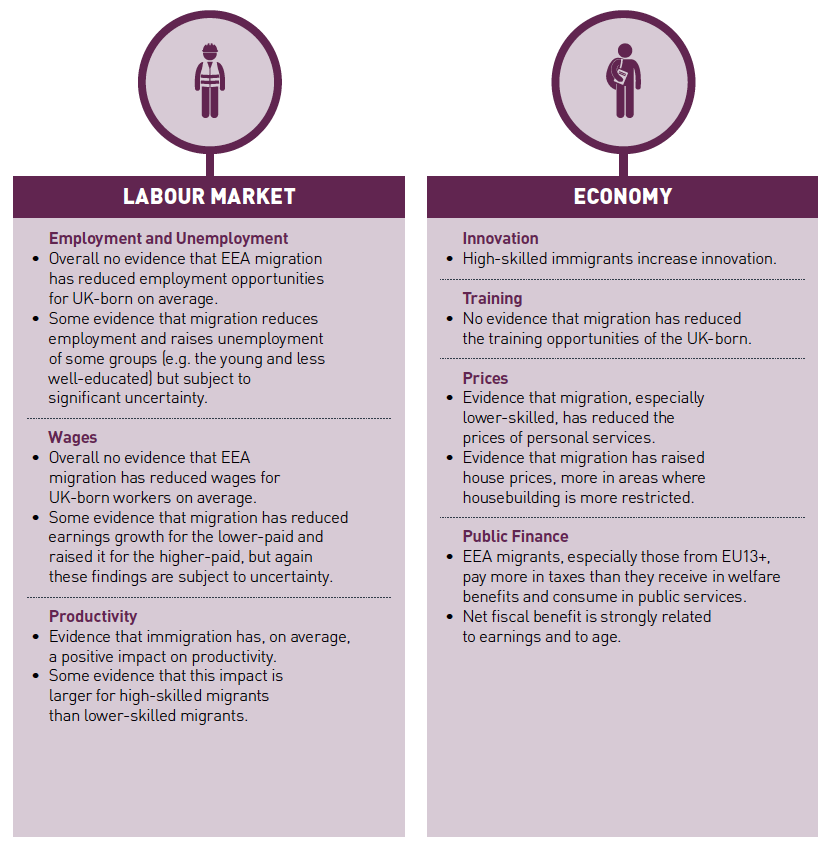
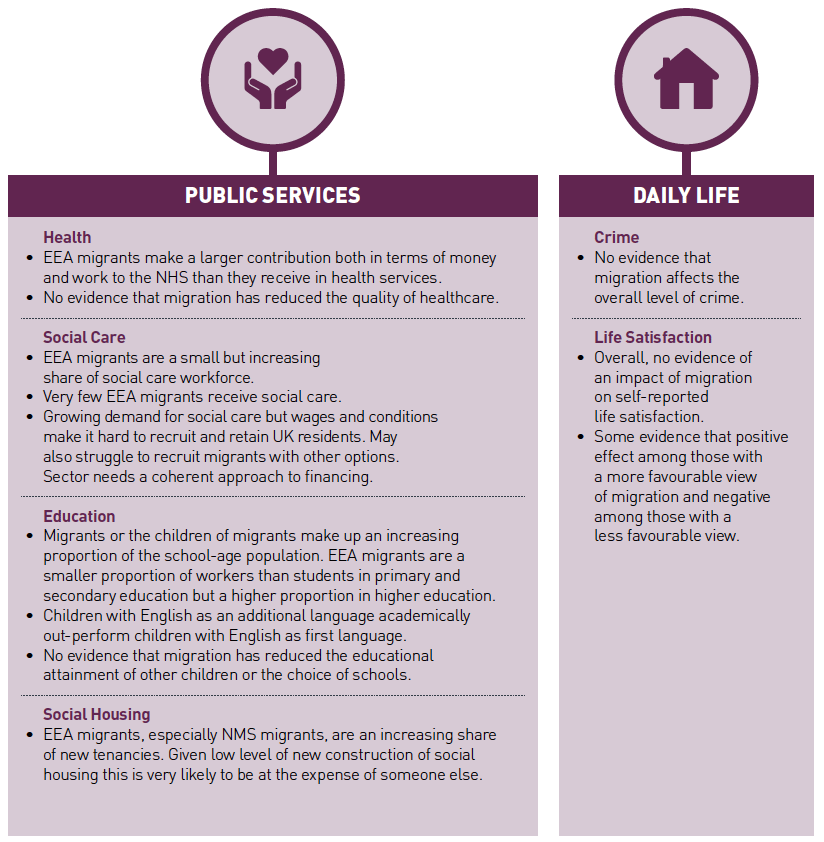
Contact
Email: Migration@gov.scot
There is a problem
Thanks for your feedback